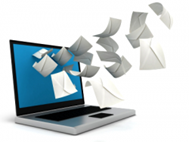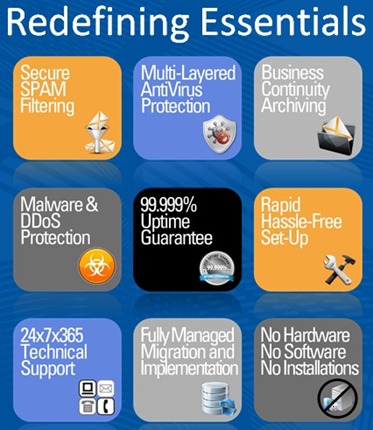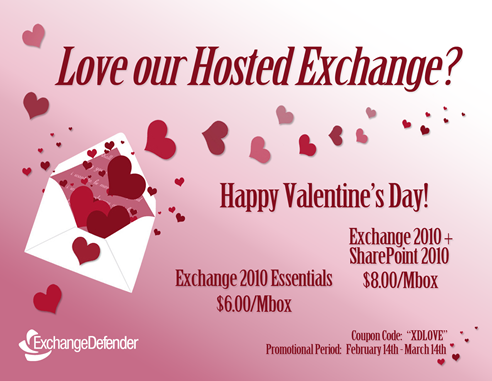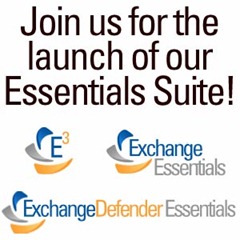ExchangeDefender Essentials: The Key Points
We launched the product a couple of weeks ago, and our CEO, Vlad Mazek, conducted a webcast last week describing the product and structure in great detail. We were thrilled to see so many great partners turn out for the live webcast, but realize that many many more just weren’t available last Thursday afternoon.
ExchangeDefender Essentials is a budget-friendly security solution that covers the basic needs of many small businesses.
The nine highlights are as follows:
So here’s a brief recap of how ExchangeDefender Essentials works:
ExchangeDefender Essentials is just fifty cents per user per month, the most competitive price on the market! A one year commitment is required unless you are “grandfathering” in existing accounts from the 1.0 Essentials version. We can handle support & billing, and we promise no catches or gotchas on support. Essentials can not be resold, rebranded or bought directly.
The new version and price will be available March 1st and existing clients will have the price reduction applied on their March 1st invoice.
The best part of all, though, is that every ExchangeDefender Essentials account includes an amazing “kicker:”
ExchangeDefender Essentials Emergency (E^3) absolutely FREE!
ExchangeDefender Essentials Emergency is a scaled down version of our popular Live Archive product, which we ended up adding into the 2.0 release because we just weren’t comfortable putting our name on a security solution that didn’t include the most critical business continuity functionality.
ExchangeDefender Essentials Emergency is exactly that. It includes five (5) days of inbound mail with compose, reply, and forward functionality. No maintenance is required, ExchangeDefender Essentials Emergency is always on and always enabled. Plus, the initial rollout is even automated. It’s always there and waiting, in case of any challenge or emergency your clients may face. And best of all, it’s free. For every user.
Do you find this information useful?
 If you’d like a lot more in-depth discussion about the cloud and how it affects you and your clients, visit Looks Cloudy http://www.lookscloudy.com where I blog daily about the adoption of the cloud in SMB, conduct live webcasts and podcasts with industry leaders, and more.
If you’d like a lot more in-depth discussion about the cloud and how it affects you and your clients, visit Looks Cloudy http://www.lookscloudy.com where I blog daily about the adoption of the cloud in SMB, conduct live webcasts and podcasts with industry leaders, and more.
Kate Hunt
VP Community Development, ExchangeDefender
kate@ownwebnow.com
(877) 546-0316 x777
Mail Flow Reloaded
 I have covered this topic here before. However, since my contribution in this blog is centered around repetitive support issues we’ll take another stab at it again since it seems that the gap in understand shows up every time we get a new batch of partners. Please feel free to print this or link this to your support staff because it’s pretty fail safe and it will save your team time as well as safe face in looking borderline incompetent when confronted with such an issue to your end users.
I have covered this topic here before. However, since my contribution in this blog is centered around repetitive support issues we’ll take another stab at it again since it seems that the gap in understand shows up every time we get a new batch of partners. Please feel free to print this or link this to your support staff because it’s pretty fail safe and it will save your team time as well as safe face in looking borderline incompetent when confronted with such an issue to your end users.
My client has reported to me that they have not received any email today (random interval of time they expected to receive mail and have not):
1. Always and foremost check the MX record. If this is pointed at anything other than or in addition to inbound30.exchangedefender.com, you’ve found your problem.
You can use a site like www.mxtoolbox.com to search this or if you’re savvy in windows cmd promp or linux there are commands to do this.2. You’ve checked the MX records and the only thing that exists is inbound30.exchangedefender.com, what do I check next?
ExchangeDefender requires 1 hour to propagate across all inbound and outbound server (2 hours during peak which is defined by 8-6 EST)You access a computer’s command prompt and attempt the following steps:
telnet inbound30.exchangedefender.com 25 <enter> (Wait for Welcome banner before proceeding)
ehlo yoursendingdomain.com <enter> (Use your actual test send domain, and wait for reply from server)
mail from: yourtest@domain.com <enter> (Use your actual test send address, and wait for reply from server)
rcpt to: yourclient@domain.com <enter> (Use your actual client address, and wait for reply from server)
DATA <enter>
Subject: Test <enter>
Testing please ignore. <enter>
. <enter> (The sole period indicates end of transmission).
Now you should have received a message ID if your test was successful. If you received such an ID the issue is not within ExchangeDefender. If you receive a relaying denied message you have not given the system enough time to populate the routing changes for your new or changed domain delivery point.
3. Log into https://admin.exchangedefender.com with your Service Provider ID (Hint: It’s not a domain nor an email address). If you need this and are unsure open a support request and we’ll provide you the credentials. Unfortunately, we cannot provide this type of information over the phone if you call in looking for this you’ll be directed as such.
Once you log in, click on Mail Log at the top then search for your test message.
If you see the status as Deferred 9 times out of 10 its either the ISP or a firewall not allowing our subnets to deliver the message, the last 1 out of 10 is the IP restrictions weren’t set in Exchange. For an updated list of our ranges please visit:
http://www.exchangedefender.com/ExchangeDefender_Deployment_Guide.php
Carlos Lascano
VP Support Services, ExchangeDefender
carlos@ownwebnow.com
(877) 546-0316 x737
ExchangeDefender Essentials Launch Webinar
Last week we launched ExchangeDefender Essentials to our partner base and unveiled the new products, the new pricing, the new business model behind it (and the ability to sell it directly) as well as a lot more details. This is a private preview for our partners and the official press release will follow on March 1st.. but for now you can check out the video and be ahead of the curve.
 Download ExchangeDefender Essentials Launch Video
Download ExchangeDefender Essentials Launch Video
Or you can order it today in the Service Manager and be way ahead of the game. The feedback so far – on the price alone – has been tremendous. We look forward to adding you to the ExchangeDefender family and giving you yet another way to compete in the marketplace and earn more business.
Don’t give your clients any reason to say no!
Sincerely,
Vlad Mazek, MCSE
CEO, Own Web Now Corp
vlad@ownwebnow.com
(877) 546-0316 x500
(407) 536-VLAD
Della Upgrade SP2 & DAG Activation
This weekend (02/24/12 – 02/25/12 19:00 Eastern [00:00 GMT]) we will be performing SP2 upgrades to the Europe Exchange 2010 Cluster: Della. Upgrade to Exchange 2010 SP2 will be performed on all passive nodes in Della. Upon successful upgrade clients will be moved from the active server to a passive node. . This upgrade is not expected to impact customer access however, there will be critical changes prior to the upgrade.
02/21/2012:
· New load balancer will be activated across the passive nodes.
· IP address for cas.della.exchangedefender.com will be modified to the new load balancer (Expected to be 213.229.89.253)
On Friday evening users on the active node will be moved to the passive nodes. The switch over from active to passive should be transparent to users.
Unfortunately, BES services may be interrupted as BES does not detect and handle upgrades seamlessly. If BES service is interrupted we will work on restoring service after SP2 has been successfully applied.
Travis Sheldon
VP, Network Operations, ExchangeDefender
(877) 546-0316 x757
travis@ownwebnow.com
Happy Valentine’s Day!
Happy Valentine’s Day to everyone from ExchangeDefender!!!
Everyone check your mailbox! We love our partners and we want to give you all a special promotion for this Valentine’s Day!
We are running an Exchange promotion! For a limited time, we are offering Hosted Exchange 2010 and SharePoint 2010 for $8.00/mailbox and Hosted Exchange Essentials 2010 for $6.00/mailbox. The promotion will run from February 14th – March 14th and be valid on any and all new accounts that are signed up during the promotional period when using the coupon code given.
Hosted Exchange 2010 + SharePoint 2010 Includes:
*Microsoft Exchange 2010
*Microsoft SharePoint 2010
*ExchangeDefender:
*SPAM & Virus Filtering
*Web Filtering
*Web File Sharing
*Encryption
*Compliance Archiving
*Live Archive Business Continuity
*Outlook License
Hosted Exchange Essentials:
*Microsoft Exchange 2010
*ExchangeDefender Essentials
*SPAM & Virus Filtering, Business Continuity
Check your mailbox for a postcard or go to www.exchangedefender.com/promotions.php for more information and to get the coupon code.
Stephanie Hasenour
VP Marketing, ExchangeDefender
stephanie@ownwebnow.com
Rockerduck Maintenance
On February 9th – February 11th 2012 the ExchangeDefender staff performed maintenance on the Rockerduck cluster in which two separate individual ‘outages’ affected client access on the late half of the evenings and early half of the following morning on February 9th -10th and February 10th-11th .
 On the eve of Feb. 9th 2012 (~11:30 PM Eastern) we began upgrades on a failed/failing VPN device that is used to connect ROCKERDUCK:DAL and ROCKERDUCK:LA active directory and internal communication between sites. During the upgrade we began to notice random network related events in which communication seemed saturated and sluggish and randomly affected across the entire network. After various attempts (and configurations) to bring the new VPN router online we determined that the new VPN device was occasionally malfunctioning and flooding the network with ‘dead packets’. Unfortunately the massive flood of packets from the VPN device caused the Database Availability Group (DAG) on ROCKERDUCK to lose communication between nodes and eventually lose quorum. Once quorum was lost between nodes all databases between both sites were automatically dismounted as the DAG was considered unhealthy to Exchange. For the next few hours we worked to restore service to RD clients by replacing the failed VPN routers with our backup VPNs (new vendor) and restoring communication with Los Angeles. After communication was re-established clients were able to access their mailboxes. This outage affected all clients and lasted between the hours of midnight and roughly 3:15 AM.
On the eve of Feb. 9th 2012 (~11:30 PM Eastern) we began upgrades on a failed/failing VPN device that is used to connect ROCKERDUCK:DAL and ROCKERDUCK:LA active directory and internal communication between sites. During the upgrade we began to notice random network related events in which communication seemed saturated and sluggish and randomly affected across the entire network. After various attempts (and configurations) to bring the new VPN router online we determined that the new VPN device was occasionally malfunctioning and flooding the network with ‘dead packets’. Unfortunately the massive flood of packets from the VPN device caused the Database Availability Group (DAG) on ROCKERDUCK to lose communication between nodes and eventually lose quorum. Once quorum was lost between nodes all databases between both sites were automatically dismounted as the DAG was considered unhealthy to Exchange. For the next few hours we worked to restore service to RD clients by replacing the failed VPN routers with our backup VPNs (new vendor) and restoring communication with Los Angeles. After communication was re-established clients were able to access their mailboxes. This outage affected all clients and lasted between the hours of midnight and roughly 3:15 AM.
On the eve of Feb. 10th (~10:30 PM Eastern) we began work to finalize the VPN communication by consolidating both VPN devices in California to the one backup vendor VPN device. The reason we elected to replace the ‘working’ VPN device in California was due to the fear of the abnormal workings of the similar VPN device in Dallas. As part of our protocol to ‘down’ a data center in Exchange hosting we paused SMTP services on Rockerduck. After replacing the VPN device in California we resumed all services (including SMTP) and mail resumed normal flow. Around 5:30 AM Eastern we started to receive alerts about back pressured queues in Rockerduck which would amount to delivery delays. Upon investigation it was discovered that the issue was mail delivery between the EDGE server network and the HUB server network on RD. After two hours of investigating the issue internally (and opening a case with Microsoft) we were able to determine that our course of action would be reapplying the SP2 update to the edge networks. Once SP2 was reapplied to all EDGE nodes mail delivery returned on ROCKERDUCK by 9:15 AM Eastern.
Finally there were about 5% of users who were left in a disconnected state through Outlook but had service through OWA (and some through active sync) between Saturday and Sunday as the database their mailboxes were housed was moved to Los Angeles for the content index database in Dallas to rebuild for RDDB9. Service was restored to these users by noon Eastern.
Travis Sheldon
VP, Network Operations, ExchangeDefender
(877) 546-0316 x757
travis@ownwebnow.com
This Week in Development…
This week the development team here at ExchangeDefender has been working towards internal fixes and upgrades across several platforms. The next few months are going to be jammed packed with a lot of exciting additions, which will help us assist you and your clients more efficiently. We’ve also made several additions and corrections inside of the Shockey Monkey service manager module.
A few areas we addressed internally were in regards to account creation and error handling when it comes to provisioning Hosted Exchange accounts. We have addressed the rare instances where an account(s) would get stuck in the “pending” state upon attempting to create a new mailbox. We were also receiving reports of several issues with the service manager when using “Internet Explorer”; we have corrected these issues as well. Essentially we’ve been trying to smooth the entire ordering process out and help make new account creations and modifications a more pleasant experience.
In regards to new features inside of the service manager, users now have the ability to add or remove distribution group account aliases. What this feature does is allow the distribution group to receive email from more than one address and still distribute the message as if it was sent to the primary email. We decided to implement this feature now because it became a request that kept growing and growing as more and more partners were creating distribution groups for their clients.
I’m looking forward to discussing the future products and changes that will occur within the next few months and helping shed light on the technical aspect of how these new products will function throughout you every day routines.
Hank Newman
VP Development, ExchangeDefender
hank@ownwebnow.com
Three Reasons Why the ExchangeDefender Launch Webcast is Going to Be Awesome!
1.) How much time do you and your team spend each month administering your client relationships that can’t be billed back to them? That is a number good business owners are constantly working to drive down. You’ll find out how we have eliminated the most difficult part of managing ExchangeDefender products and services.
2.) Whatever the specific size and scope of your clients’ needs, the ExchangeDefender suite including Essentials can help you deliver just the services that your clients really need at an unbeatable price. You’ll find out how you can make a bigger margin while delivering “right-sized” solutions.
3.) Understand how delivering built-in free business continuity can permanently change your client relationships for the better. What if you could add this value to every client engagement without increasing your costs?
Join us for the ExchangeDefender Essentials launch webcast on Thursday, February 16th at Noon EST.
Register here: http://www.exchangedefender.com/blog/2012/02/essentials-launch/
Do you find this information useful?
 If you’d like a lot more in-depth discussion about the cloud and how it affects you and your clients, visit Looks Cloudy http://www.lookscloudy.com where I blog daily about the adoption of the cloud in SMB, conduct live webcasts and podcasts with industry leaders, and much more.
If you’d like a lot more in-depth discussion about the cloud and how it affects you and your clients, visit Looks Cloudy http://www.lookscloudy.com where I blog daily about the adoption of the cloud in SMB, conduct live webcasts and podcasts with industry leaders, and much more.
Kate Hunt
VP Community Development, ExchangeDefender
kate@ownwebnow.com
(877) 546-0316 x777
Essentials Launch
Please join us next Thursday, February 16th, at noon EST for the launch of ExchangeDefender Essentials suite.
Click here to register now, limited capacity:
We have blogged a lot about ExchangeDefender Essentials, E^3, Emergency and we’re officially launching it next week. This is our biggest competitive product launch so please make sure you tune in for special pricing offer that will be extended only during the webinar (you can lock it in, no purchase necessary).
Talk to you next Thursday!
Sincerely,
Vlad Mazek, MCSE
CEO, Own Web Now Corp
vlad@ownwebnow.com
(877) 546-0316 x500
(407) 536-VLAD
Maintenance Weekend
 This weekend a big part of our team will be doing some massive infrastructure upgrades to improve our network performance and stability in our Dallas DC. These changes should not have any effect on service if we find that the planned change may impact a service of some sort we will be sure to update the NOC blog accordingly. Remember that it’s available at http://www.exchangedefender.com/noc and it’s RSS enabled at http://www.exchangedefender.com/noc/feed/ for you to subscribe for yourself and your staff.
This weekend a big part of our team will be doing some massive infrastructure upgrades to improve our network performance and stability in our Dallas DC. These changes should not have any effect on service if we find that the planned change may impact a service of some sort we will be sure to update the NOC blog accordingly. Remember that it’s available at http://www.exchangedefender.com/noc and it’s RSS enabled at http://www.exchangedefender.com/noc/feed/ for you to subscribe for yourself and your staff.
We will also be increasing our power capability by 20% this will help us with any required growth we may need due to business growth. We’ll also begin deploying a new 2010 cluster, but I can’t provide any additional details on that as Vlad will share that news once it’s live as far its purpose and target.
 The last change will impact one of our backup servers, backup90 as it will receive a storage upgrade to accommodate increasing demand for that service in the upcoming months. The service impact there should be minimal and will be blogged.
The last change will impact one of our backup servers, backup90 as it will receive a storage upgrade to accommodate increasing demand for that service in the upcoming months. The service impact there should be minimal and will be blogged.
So we are basically doing a big push to create a big buffer on the availability and performance so that your teams can continue to focus on just moving the product, we will take care of the ugly part of the business for you!
Carlos Lascano
VP Support Services, ExchangeDefender
carlos@ownwebnow.com
(877) 546-0316 x737



